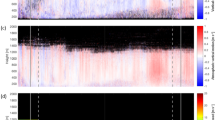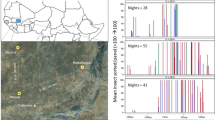Abstract
Insects migrating at high altitude over southern Britain have been continuously monitored by automatically operating, vertical-looking radars over a period of several years. During some occasions in the summer months, the migrants were observed to form well-defined layer concentrations, typically at heights of 200–400 m, in the stable night-time atmosphere. Under these conditions, insects are likely to have control over their vertical movements and are selecting flight heights that are favourable for long-range migration. We therefore investigated the factors influencing the formation of these insect layers by comparing radar measurements of the vertical distribution of insect density with meteorological profiles generated by the UK Meteorological Office’s (UKMO) Unified Model (UM). Radar-derived measurements of mass and displacement speed, along with data from Rothamsted Insect Survey light traps, provided information on the identity of the migrants. We present here three case studies where noctuid and pyralid moths contributed substantially to the observed layers. The major meteorological factors influencing the layer concentrations appeared to be: (a) the altitude of the warmest air, (b) heights corresponding to temperature preferences or thresholds for sustained migration and, (c) on nights when air temperatures are relatively high, wind-speed maxima associated with the nocturnal jet. Back-trajectories indicated that layer duration may have been determined by the distance to the coast. Overall, the unique combination of meteorological data from the UM and insect data from entomological radar described here show considerable promise for systematic studies of high-altitude insect layering.











Similar content being viewed by others
Notes
FBL: The layer of air next to the ground where wind speed is lower than an insect’s flight speed and hence where an insect has control over its velocity.
References
Beerwinkle KR, Lopez JD, Witz JA, Schleider PG, Eyster RS, Lingren PD (1994) Seasonal radar and meteorological observations associated with nocturnal insect flight at altitudes to 900 metres. Env Entomol 23(3):676–683
Campistron B (1975) Characteristic distributions of angel echoes in the lower atmosphere and their meteorological implications. Boundary-Layer Meteorol 9:411–426
Chapman JW, Reynolds DR, Smith AD, Riley JR, Pedgley DE, Woiwod IP (2002a) High−altitude migration of the diamondback moth Plutella xylostella to the U.K.: a study using radar, aerial netting, and ground trapping. Ecol Ent 27:641–650
Chapman JW, Smith AD, Woiwod IP, Reynolds DR, Riley JR (2002b) Development of vertical−looking radar technology for monitoring insect migration. Comp Electron Agric 35:95–110
Chapman JW, Reynolds DR, Smith AD (2003) Vertical−looking radar: a new tool for monitoring high−altitude insect migration. Bioscience 53:503–511
Chapman JW, Reynolds DR, Smith AD (2004) Migratory and foraging movements in beneficial insects: a review of radar monitoring and tracking methods. Int J Pest Manag 50:225–232
Chen RL, Bao XZ, Drake VA, Farrow RA, Wang SY, Sun YJ, Zhai BP (1989) Radar observations of the spring migration into northeastern China of the oriental armyworm moth, Mythimna separata and other insects. Ecol Ent 14:149–162
Clark DP (1969) Night flights of the Australian plague locust, Chortoicetes terminifera Walk., in relation to storms. Aust J Zool 17:329–352
Cullen MJP, Davies T, Mawson MH, James JA, Coulter SC, Malcolm A (1997) An overview of numerical methods for the next generation UK NWP and climate model. In: Lin CA, Laprise R, Ritchie H (eds) Numerical Methods in Atmospheric and Ocean Modelling: The Andre J. Robert memorial volume. Canadian Meteorological and Oceanographic Society, Ottawa, Canada, pp 425–444
Dickison RBB, Haggis MJ, Rainey, RC (1983) Spruce budworm moth flight and storms: case study of a cold front system. J Clim Appl Meteorol 22:278–286
Drake VA (1984) The vertical distribution of macro−insects migrating in the nocturnal boundary layer: a radar study. Bound−Layer Meteorol 28:353–374
Drake VA (1985) Solitary wave disturbances of the nocturnal boundary layer revealed by radar observations of migrating insects. Bound-Layer Meteorol 31:269–286
Drake VA (2002) Automatically operating radar for monitoring insect pest migrations. Entomol Sinica 9(4):27–39
Drake VA, Farrow RA (1985) A radar and aerial-trapping study of an early spring migration of moths (Lepidoptera) in inland New South Wales. Aust J Ecol 10:223–235
Drake VA, Farrow RA (1988) The influence of atmospheric structure and motions on insect migration. Ann Rev Ent 33:183–210
Drake VA, Gatehouse AG (1995) (eds) Insect Migration: Tracking Resources through Space and Time. Cambridge University Press, Cambridge, UK
Drake VA, Helm KF, Readshaw JL, Reid DG (1981) Insect migration across Bass Strait during spring: a radar study. Bull Ent Res 71:449–466
Drake VA, Rochester WA (1994) The formation of layer concentrations by migrating insects. In: Proceedings of 21st Conference on Agricultural and Forest Meteorology - 11th Conference on Biometeorology, March 7–11 1994, San Diego, California. American Meteorological Society, Boston, pp. 411–414
Essery R, Best M, Cox P (2001) MOSES 2.2 Technical Documentation, Hadley Centre Technical Report No. 30, UK Met. Office Hadley Centre
Farrow RA (1981) Aerial dispersal of Scelio fulgidus (Hym.: Scelionidae), parasite of eggs of locusts and grasshoppers (Ort.: Acrididae). Entomophaga 26:349–355
Feng HQ, Wu KM, Cheng DF, Guo YY (2003) Radar observations of the autumn migration of the beet armyworm Spodoptera exigua (lepidoptera: Noctuidae) and other moths in northern china. Bull Ent Res 93:115–124
Feng HQ, Wu KM, Cheng DF, Guo YY (2004) Spring migration and summer dispersal of Loxostege sticticalis (Lepidoptera: Pyralidae) and other insects observed with radar in northern China. Env Entomol 33:1253–1265
Garratt JR (1994) The atmospheric boundary layer. Cambridge atmospheric and space series. Cambridge University Press, Cambridge
Gatehouse AG (1997) Behavior and ecological genetics of wind-borne migration by insects. Ann Rev Ent 42:475–502
Greenbank DO, Schaefer GW, Rainey RC (1980) Spruce budworm (Lepidoptera: Tortricidae) moth flight and dispersal: new understanding from canopy observations, radar, and aircraft. Mem Ent Soc Canada 110:1–49
Gregory D, Rowntree PR (1990) A mass flux convection scheme with representation of cloud ensemble characteristics and stability-dependent closure. Mon Wea Rev 118:1483–1506
Hobbs SE, Wolf WW (1989) An airborne radar technique for studying insect migration. Bull Ent Res 79:693–704
Irwin ME, Thresh JM (1988) Long range aerial dispersal of cereal aphids as virus vectors in North America. Phil Trans Roy Soc Lond B 321:421–446
Johnson CG (1969) Migration and Dispersal of Insects by Flight. Methuen and Co, London
Larsen EB (1949) Activity and migration of Plusia gamma L. Studies on the activity of insects. III. Biologiske meddelelser 21(4):1–32
Lewis T, Taylor LR (1967) Introduction to experimental ecology. Academic Press, London
Lingren PD, Raulston JR, Popham TW, Wolf WW, Lingren PS, Esquivel JF (1995) Flight behaviour of corn earworm (Lepidoptera: Noctuidae) moths under low wind speed conditions. Env Entomol 24:851–860
Lock AP, Brown AR, Bush MR, Martin GM, Smith RNB (2000) A new boundary layer mixing scheme. Part 1: Scheme description and single-column model tests. Mon Wea Rev 128:3187–3199
Mahrt L, Heald RC, Lenschow DH, Stankov, BB, Troen I (1979) An observational study of the structure of the nocturnal boundary layer. Bound-Layer Meteorol 17:247–264
Mel’nichenko AN (1936) Regularities of mass flying of the adult Loxostege sticticalis L., and the problem of prognosis of their flight migrations. Bulletin Plant Protection, Leningrad. Series 1, Entomology, no. 17 (see Rev Appl Entomol (A) 24:816–817)
Pedgley DE (1982) Windborne pests and diseases: meteorology of airborne organisms. Ellis Horwood, Chichester, UK
Pedgley DE (1993) Managing migratory insects pests - a review. Int J Pest Manag 39:3–12
Pedgley DE, Reynolds DR, Riley JR, Tucker MR (1982) Flying insects reveal small-scale wind systems. Weather 37:295–306
Pedgley DE, Reynolds DR, Tatchell GM (1995) Long-range insect migration in relation to climate and weather: Africa and Europe. In: Drake VA, Gatehouse AG (eds) Insect Migration: Tracking Resources through Space and Time. Cambridge University Press, Cambridge, UK, pp. 3–29
Rainey RC (1974) Biometeorology and insect flight: some aspects of energy exchange. Ann Rev Ent 19:407–439
Reid DG, Wardhaugh KG, Roffey J (1979) Radar studies of insect flight at Benalla, Victoria, in February 1974. CSIRO Australia, Division of Entomology Technical Paper no. 16
Reynolds DR, Chapman JW, Edwards AS, Smith AD, Wood CR, Barlow JF, Woiwod IP (2005) Radar studies of the vertical distribution of insects migrating over southern Britain: the influence of temperature inversions on nocturnal layer concentrations. Bull Ent Res 95:259–274
Reynolds DR, Riley JR (1997) The flight behaviour and migration of insect pests: radar studies in developing countries. NRI Bulletin no. 71. Natural Resources Institute, Chatham, UK
Riley JR (1989) Orientation by high−flying insects at night: observations and theories. In: Orientation and Navigation − Birds, Humans and other animals. Conference of the Royal Institute of Navigation, Cardiff, 6−8 April 1989. The Royal Institute of Navigation, London
Riley JR, Cheng XN, Zhang XX, Reynolds DR, Xu GM, Smith AD, Cheng JY, Bao AD, Zhai BP (1991) The long−distance migration of Nilaparvata lugens (Stål) (Delphacidae) in China: radar observations of mass return flight in the autumn. Ecol Ent 16:471–489
Riley JR, Reynolds DR (1979) Radar−based studies of the migratory flight of grasshoppers in the middle Niger area of Mali. Proc Roy Soc Lond B 204:67–82
Riley JR, Reynolds DR (1986) Orientation at night by high-flying insects. In: Danthanarayana, W (ed) Insect Flight: Dispersal and Migration, Springer-Verlag, Berlin, Heidelberg, pp. 71–87
Riley JR, Reynolds DR, Farmery MJ (1983) Observations of the flight behaviour of the armyworm moth, Spodoptera exempta, at an emergence site using radar and infra-red optical techniques. Ecol Ent 8:395–418
Riley JR, Reynolds DR, Farrow RA (1987) The migration of Nilaparvata lugens (Stål) (Delphacidae) and other Hemiptera associated with rice during the dry season in the Philippines: a study using radar, visual observations, aerial netting and ground trapping. Bull Ent Res 77:145–169
Schaefer GW (1976) Radar observations of insect flight. Symp R Ento Soc Lond 7:157–197
Smith AD, Reynolds DR, Riley JR (2000) The use of vertical−looking radar to continuously monitor the insect fauna flying at altitude over southern England. Bull Ent Res 90:265–277
Smith AD, Riley JR, Gregory RD (1993) A method for routine monitoring of the aerial migration of insects by using a vertical−looking radar. Phil Trans Royal Soc Lond B 340:393–404
Taylor LR (1974) Insect migration, flight periodicity and the boundary layer. J Anim Ecol 43:225–238
Taylor LR, Carter CI (1961) The analysis of numbers and distribution in an aerial population of macrolepidoptera. Trans Roy Ent Soc Lond 113:369–386
Taylor LR, French RA, Macaulay EDM (1973) Low-altitude migration and diurnal flight periodicity; the importance of Plusia gamma L. (Lepidoptera: Plusidae). J Anim Ecol 42:751–760
Thorpe AJ, Guymer TH (1977) The nocturnal jet. Quart J R Meteorol Soc 103:633–653
Vaughn CR (1985) Birds and insects as radar targets: a review. Proc IEEE 73:205–227
Wilson DR, Ballard SP (1999) A microphysically based precipitation scheme for the UK Meteorological Office Unified Model. Quart J R Meteorol Soc 125:1607–1636
Woiwod IP, Harrington R (1994) Flying in the face of change - the Rothamsted Insect Survey. In: Leigh RA, Johnson AE (eds) Long-term experiments in agricultural and ecological sciences. CAB International, Wallingford, UK, pp. 321–342
Wolf WW, Westbrook JK, Raulston J, Pair SD, Hobbs SE (1990) Recent airborne radar observations of migrant pests in the United States. Phil Trans Roy Soc B 328:619–630
Wolf WW, Westbrook JK, Sparks AN (1986) Relationships between radar entomological measurements and atmospheric structure in south Texas during March and April 1982. In: Sparks AN (ed) Long-range migration of moths of agronomic importance to the United States and Canada: Specific examples of the occurrence and synoptic weather patterns conducive to migration. U.S. Department of Agriculture, Agricultural Research Service ARS-43, pp. 84–97
Acknowledgements
We thank Pete Clark from the UK Met. Office’s Joint Centre for Mesoscale Meteorology for UM data, Helen Webster from the UK Met. Office’s Atmospheric Dispersion Group for back-trajectory analyses and Ann Edwards for obtaining the insect alignment results. This work was supported by the UK Biotechnology and Biological Sciences Research Council (BBSRC) grant BBS/S/L/2003/10273 and a UK Met. Office CASE studentship.
Author information
Authors and Affiliations
Corresponding author
Rights and permissions
About this article
Cite this article
Wood, C.R., Chapman, J.W., Reynolds, D.R. et al. The influence of the atmospheric boundary layer on nocturnal layers of noctuids and other moths migrating over southern Britain. Int J Biometeorol 50, 193–204 (2006). https://doi.org/10.1007/s00484-005-0014-7
Received:
Revised:
Accepted:
Published:
Issue Date:
DOI: https://doi.org/10.1007/s00484-005-0014-7




